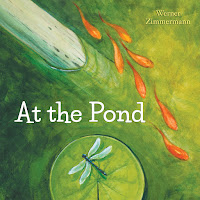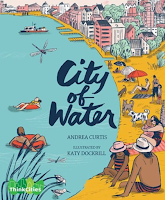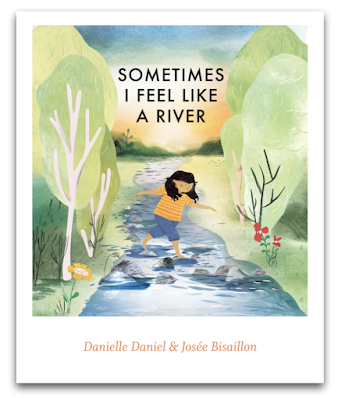March 22 has been designed
World Water Day. It's a day to celebrate water, from its role in our lives to our role in its sustainability and protection. From drinking water to rivers, and oceans to ponds, water plays a critical role in our lives and we in its. Some of these books celebrate our everyday relationships with water, from its life-sustaining role to our use of it for swimming, but some, especially those for older readers, emphasize the power of water during storms and floods. Others speak to the inequities of water availability and our role in water's conservation. Whether encouraging young children to recognize water as more than the stuff that comes out of the taps, or inspiring them to action, these picture books, novels and non-fiction books all remind us to consider the role water plays in our lives.
Written by Olive Senior
Illustrated by Laura James
Tradewind Books
40 pp.
Ages 3-6
2014
Written and illustrated by Werner Zimmermann
North Winds Press (Scholastic Canada)
32 pp.
Ages 2-5
2018
Reviewed here The Case of the Shrinking Friend (
A Gumboot Kids Nature Mystery)
Written by Eric Hogan and Tara Hungerford
Firefly Books
32 pp.
Ages 4-8
2021
City of Water (ThinkCities)
Written by Andrea Curtis
Illustrated by Katy Dockrill
Groundwood Books
40 pp.
Ages 8-10
2021
Dive In! Exploring Our Connections with the Ocean (Orca Footprint) Written by Ann Eriksson
Orca Book Publishers
75 pp.
Ages 9-12
2018
Eco Warrior (Submarine Outlaw)
Written by Philip Roy
Ronsdale Press
200 pp.
Ages 10+
2015
Every Last Drop: Bringing Clean Water Home (Orca Footprint) Written by Michelle Mulder
Orca Book Publishers
48 pp.
Ages 8-12
2014
Fresh Air, Clean Water: Our Right to a Healthy EnvironmentWritten by Megan Clendenan
Illustrated by Julie McLaughlin
Orca Book Publishers
112 pp.
Ages 9-12
2022
Written by Alma Fullerton
Illustrated by Karen Patkau
Pajama Press
32 pp.
Ages 5+
2012
Written by Karin Adams
Illustrated by Janine Carrington
James Lorimer & Co.
150 pp.
Ages 7-11
2017
My River: Cleaning Up the LaHave River Written by Anne Laurel Carter
Formac
96 pp.
Ages 7-12
2018
Written by Sunshine Tenasco
Illustrated by Chief Lady Bird
North Winds Press (Scholastic Canada)
32 pp.
Ages 4-8
2019
No More PlasticWritten and illustrated by Alma Fullerton
Pajama Press
32 pp.
Ages 4-7
2021
One Well: The Story of Water on Earth Rochelle Strauss
Illustrated by Rosemary Woods
Kids Can Press
32 pp.
Ages 8-13
2007
Ryan and Jimmy and the Well in Africa that Brought Them Together (CitizenKid) Written by Herb Shoveller
Kids Can Press
56 pp.
Ages 10-14
2006
Written by Eric Walters
Puffin Canada
176 pp.
Ages 10+
2007
Shark Lady: The True Story of How Eugenie Clark Became the Ocean's Most Fearless Scientist Written by Jess Keating
Illustrated by Marta Álvarez Miguéns
Sourcebooks Jabberwocky
40 pp.
Ages 4+
2017
Written and illustrated by Gary Clement
Groundwood Books
48 pp.
Ages 4-7
April 2015
Written by Maggie de Vries
Illustrated by Janice Kun
Orca Book Publishers
32 pp.
Ages 4-8
2018
A Terrible Tide: A Story of the Newfoundland Tsunami of 1929Written by Suzanne Meade
Second Story Press
177 pp.
Ages 9-12
2021
Written by Riel Nason
Goose Lane Editions
273 pp.
Ages 12+
2011
Treaty Words: For As Long As the Rivers Flow Written by Aimée Craft
Illustrated by Luke Swinson
Annick Press
60 pp.
Ages 10+
2021
Upstream, Downstream: Exploring Watershed Connections (Orca Footprint)Written by Rowena Rae
Orca Book Publishers
48 pp.
Ages 9-12
2021
Walking for Water: How One Boy Stood Up for Gender Equality (CitizenKid)
Written by Susan Hughes
Illustrated by Nicole Miles
Kids Can Press
32 pp.
Ages 7-10
2021
Water's Children: Celebrating the resource that unites us all Written by Angèle Delaunois
Illustrated by Gérard Frischeteau
Translated by Erin Woods
Pajama Press
32 pp.
Ages 4-8
2017
Written and illustrated by Joanne Robertson
Second Story Press
36 pp.
Ages 6-9
2017
Written and illustrated by Jessica Bromley Bartram
Fitzhenry & Whiteside
32 pp.
Ages 5+
2021
Reviewed hereWater, WaterWritten by Cary Fagan
Illustrated by Jon McNaught
Tundra Books
151 pp.
Ages 8-11
2022
Water Wow!: A Visual Exploration Written by Paula Ayer and Antonia Banyard
Illustrated by Belle Wuthrich
Annick Presss
64 pp.
Ages 9-12
2016
Written and illustrated by Carey Sookocheff
Henry Holt and Company
32 pp.
Ages 4-8
2017
Who Needs a Swamp? (A Wetland Ecosystem) Written and illustrated by Karen Patkau
Tundra
32 pp.
Ages 7-10
20212
Whoosh! A Watery World of Wonderful Creatures Written by Marilyn Baillie
Illustrated by Susan Mitchell
Owlkids Books
32 pp.
Ages 3-7
2014



















































